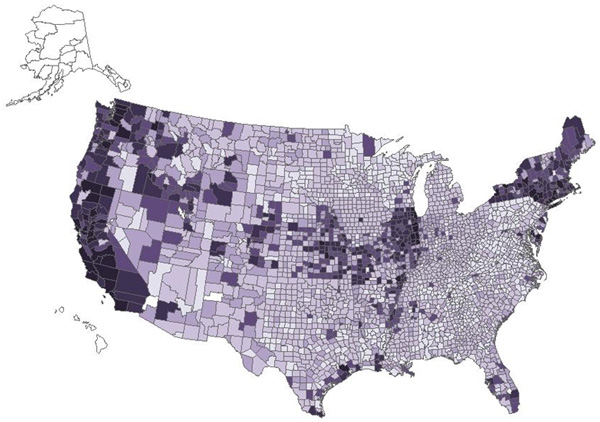end of header
Newsroom Archive
Release Information
Contact: Brian Lavin
Public Information Office
301-763-3030
FOR IMMEDIATE RELEASE: THURSDAY, AUG. 30, 2012
Census Bureau Reports There Are 89,004 Local Governments in the United States
The U.S. Census Bureau today released preliminary counts of local governments as the first component of the 2012 Census of Governments.
In 2012, 89,004 local governments existed in the United States, down from 89,476 in the last census of governments conducted in 2007. Local governments included 3,031 counties (down from 3,033 in 2007), 19,522 municipalities (up from 19,492 in 2007), 16,364 townships (down from 16,519 in 2007), 37,203 special districts (down from 37,381 in 2007) and 12,884 independent school districts (down from 13,051 in 2007).
Conducted every five years (for years ending in "2" and "7"), the census of governments provides the only uniform source of statistics for all of the nation's state and local governments. These statistics allow for in-depth trend analysis of all individual governments and provide a complete, comprehensive and authoritative benchmark of state and local government activity.
The census of governments measures three components: organization, employment and finance. These components provide statistics on the number of governments that exist, the services they provide, the number of their employees and their financial activity. In addition to the information provided for states, cities, counties and townships, the census of governments also provides information on special districts and school districts.
Other Key Findings
Among the key findings in the 2012 Census of Governments preliminary counts:
- Illinois leads the nation with 6,968 local governments — approximately 2,000 more than second-place Pennsylvania.
- Hawaii has 21 local governments, the fewest of any state.
- Texas remains first in the nation with the most independent school districts at 1,079. Closely behind is California, with 1,025 independent school districts.
- Seventeen states had more special districts compared with 2007, and 29 had fewer. Five states (including the District of Columbia) had no change.
- Ten states had fewer townships because of mergers and consolidations. Kansas decreased the most, moving from 1,353 in 2007 to 1,268 in 2012, a decrease of 85.
History of Special Districts and School Districts in the United States
Every five years since 1952, the Census Bureau has completed a comprehensive count of all local governments in the country. The most dramatic changes have been the decline in independent school districts and the notable increase in special districts. An interactive history of the counts of special districts and school districts from 1952 to 2012 can be accessed at www.census.gov/topics/public-sector/government-organization.html or by clicking on the graphic below.

Special districts are organized local entities other than county, municipal, township or school district governments that are authorized by state law to provide only one or a limited number of designated functions. Fire districts, water districts, library districts and transit authorities are examples of special districts.
School districts are created to provide elementary, secondary and/or higher education services and have sufficient administrative and fiscal autonomy to qualify as independent governments. They exclude school systems that are "dependent" on a county, municipal, township or state government.
Accessing the Information for the 2012 Census of Governments
The preliminary counts for the first component of the 2012 Census of Governments can be found on the Census Bureau's Governments Division website at www.census.gov/topics/public-sector/government-organization.html. Final counts will be issued in September 2013. For more information on the Government Units Survey, which produces these counts, go to www.census.gov/programs-surveys/cog.html.
The employment component of the 2012 Census of Governments, which began in March of 2012, collects information on the number of state and local government civilian employees and their payrolls. In October 2012, the finance component will collect information on revenues, expenditures, assets, debt and pensions. For more information on the 2012 Census of Governments and statistics about governments, go to www.census.gov/programs-surveys/cog.html.
Comments or suggestions?




